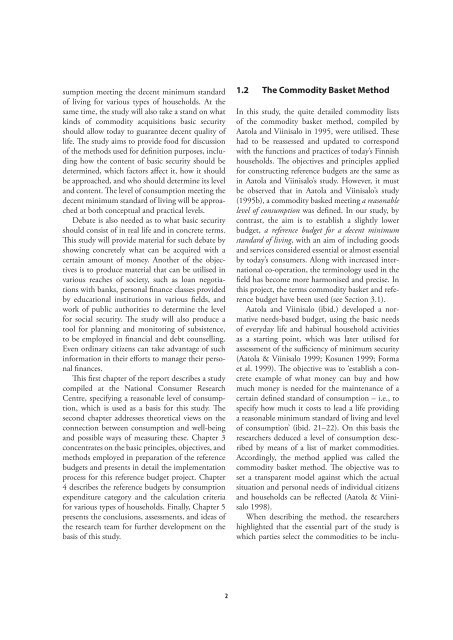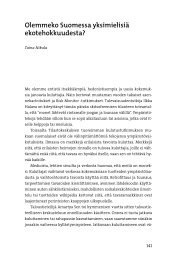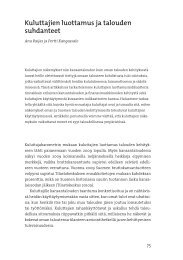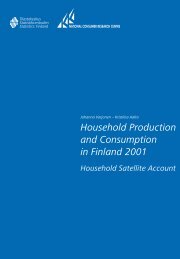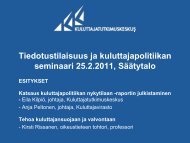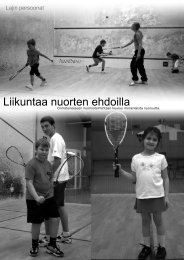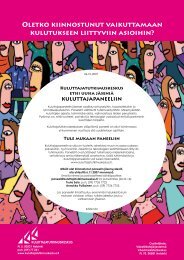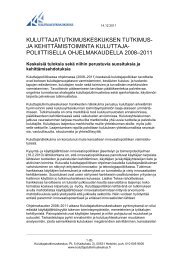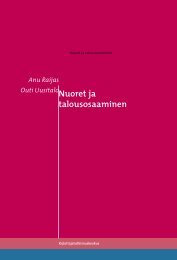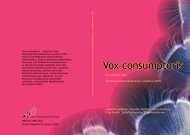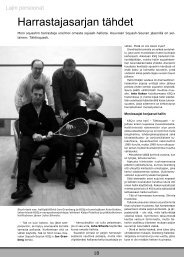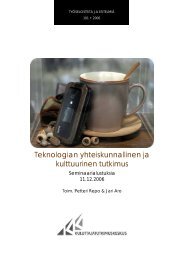working papers "What is the Cost of Living?" - Reference Budgets
working papers "What is the Cost of Living?" - Reference Budgets
working papers "What is the Cost of Living?" - Reference Budgets
You also want an ePaper? Increase the reach of your titles
YUMPU automatically turns print PDFs into web optimized ePapers that Google loves.
sumption meeting <strong>the</strong> decent minimum standard<br />
<strong>of</strong> living for various types <strong>of</strong> households. At <strong>the</strong><br />
same time, <strong>the</strong> study will also take a stand on what<br />
kinds <strong>of</strong> commodity acqu<strong>is</strong>itions basic security<br />
should allow today to guarantee decent quality <strong>of</strong><br />
life. The study aims to provide food for d<strong>is</strong>cussion<br />
<strong>of</strong> <strong>the</strong> methods used for definition purposes, including<br />
how <strong>the</strong> content <strong>of</strong> basic security should be<br />
determined, which factors affect it, how it should<br />
be approached, and who should determine its level<br />
and content. The level <strong>of</strong> consumption meeting <strong>the</strong><br />
decent minimum standard <strong>of</strong> living will be approached<br />
at both conceptual and practical levels.<br />
Debate <strong>is</strong> also needed as to what basic security<br />
should cons<strong>is</strong>t <strong>of</strong> in real life and in concrete terms.<br />
Th<strong>is</strong> study will provide material for such debate by<br />
showing concretely what can be acquired with a<br />
certain amount <strong>of</strong> money. Ano<strong>the</strong>r <strong>of</strong> <strong>the</strong> objectives<br />
<strong>is</strong> to produce material that can be util<strong>is</strong>ed in<br />
various reaches <strong>of</strong> society, such as loan negotiations<br />
with banks, personal finance classes provided<br />
by educational institutions in various fields, and<br />
work <strong>of</strong> public authorities to determine <strong>the</strong> level<br />
for social security. The study will also produce a<br />
tool for planning and monitoring <strong>of</strong> subs<strong>is</strong>tence,<br />
to be employed in financial and debt counselling.<br />
Even ordinary citizens can take advantage <strong>of</strong> such<br />
information in <strong>the</strong>ir efforts to manage <strong>the</strong>ir personal<br />
finances.<br />
Th<strong>is</strong> first chapter <strong>of</strong> <strong>the</strong> report describes a study<br />
compiled at <strong>the</strong> National Consumer Research<br />
Centre, specifying a reasonable level <strong>of</strong> consumption,<br />
which <strong>is</strong> used as a bas<strong>is</strong> for th<strong>is</strong> study. The<br />
second chapter addresses <strong>the</strong>oretical views on <strong>the</strong><br />
connection between consumption and well-being<br />
and possible ways <strong>of</strong> measuring <strong>the</strong>se. Chapter 3<br />
concentrates on <strong>the</strong> basic principles, objectives, and<br />
methods employed in preparation <strong>of</strong> <strong>the</strong> reference<br />
budgets and presents in detail <strong>the</strong> implementation<br />
process for th<strong>is</strong> reference budget project. Chapter<br />
4 describes <strong>the</strong> reference budgets by consumption<br />
expenditure category and <strong>the</strong> calculation criteria<br />
for various types <strong>of</strong> households. Finally, Chapter 5<br />
presents <strong>the</strong> conclusions, assessments, and ideas <strong>of</strong><br />
<strong>the</strong> research team for fur<strong>the</strong>r development on <strong>the</strong><br />
bas<strong>is</strong> <strong>of</strong> th<strong>is</strong> study.<br />
1.2 The Commodity Basket Method<br />
In th<strong>is</strong> study, <strong>the</strong> quite detailed commodity l<strong>is</strong>ts<br />
<strong>of</strong> <strong>the</strong> commodity basket method, compiled by<br />
Aatola and Viin<strong>is</strong>alo in 1995, were util<strong>is</strong>ed. These<br />
had to be reassessed and updated to correspond<br />
with <strong>the</strong> functions and practices <strong>of</strong> today’s Finn<strong>is</strong>h<br />
households. The objectives and principles applied<br />
for constructing reference budgets are <strong>the</strong> same as<br />
in Aatola and Viin<strong>is</strong>alo’s study. However, it must<br />
be observed that in Aatola and Viin<strong>is</strong>alo’s study<br />
(1995b), a commodity basked meeting a reasonable<br />
level <strong>of</strong> consumption was defined. In our study, by<br />
contrast, <strong>the</strong> aim <strong>is</strong> to establ<strong>is</strong>h a slightly lower<br />
budget, a reference budget for a decent minimum<br />
standard <strong>of</strong> living, with an aim <strong>of</strong> including goods<br />
and services considered essential or almost essential<br />
by today’s consumers. Along with increased international<br />
co-operation, <strong>the</strong> terminology used in <strong>the</strong><br />
field has become more harmon<strong>is</strong>ed and prec<strong>is</strong>e. In<br />
th<strong>is</strong> project, <strong>the</strong> terms commodity basket and reference<br />
budget have been used (see Section 3.1).<br />
Aatola and Viin<strong>is</strong>alo (ibid.) developed a normative<br />
needs-based budget, using <strong>the</strong> basic needs<br />
<strong>of</strong> everyday life and habitual household activities<br />
as a starting point, which was later util<strong>is</strong>ed for<br />
assessment <strong>of</strong> <strong>the</strong> sufficiency <strong>of</strong> minimum security<br />
(Aatola & Viin<strong>is</strong>alo 1999; Kosunen 1999; Forma<br />
et al. 1999). The objective was to ‘establ<strong>is</strong>h a concrete<br />
example <strong>of</strong> what money can buy and how<br />
much money <strong>is</strong> needed for <strong>the</strong> maintenance <strong>of</strong> a<br />
certain defined standard <strong>of</strong> consumption – i.e., to<br />
specify how much it costs to lead a life providing<br />
a reasonable minimum standard <strong>of</strong> living and level<br />
<strong>of</strong> consumption’ (ibid. 21–22). On th<strong>is</strong> bas<strong>is</strong> <strong>the</strong><br />
researchers deduced a level <strong>of</strong> consumption described<br />
by means <strong>of</strong> a l<strong>is</strong>t <strong>of</strong> market commodities.<br />
Accordingly, <strong>the</strong> method applied was called <strong>the</strong><br />
commodity basket method. The objective was to<br />
set a transparent model against which <strong>the</strong> actual<br />
situation and personal needs <strong>of</strong> individual citizens<br />
and households can be reflected (Aatola & Viin<strong>is</strong>alo<br />
1998).<br />
When describing <strong>the</strong> method, <strong>the</strong> researchers<br />
highlighted that <strong>the</strong> essential part <strong>of</strong> <strong>the</strong> study <strong>is</strong><br />
which parties select <strong>the</strong> commodities to be inclu-


